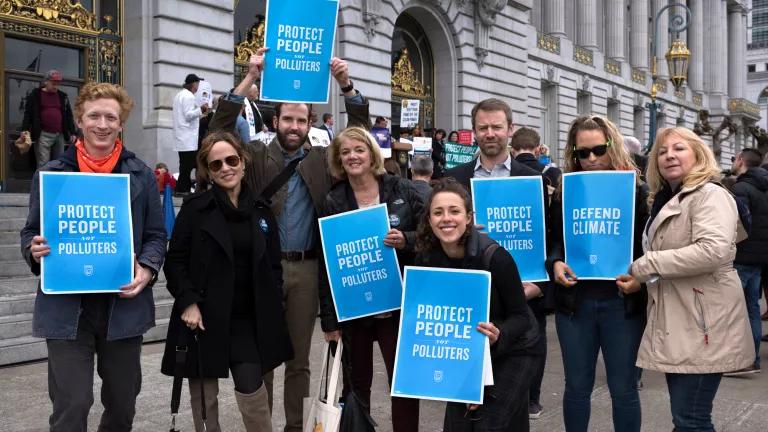
The momentum in 2015 will spur even more climate progress in 2016.
When the gavel came down closing the Paris climate talks on December 12, representatives from nearly 200 countries erupted into applause in an unprecedented show of unity for ambitious climate action.
The Paris agreement ensures 2015 will be remembered as a turning point in the climate fight, but it wasn't the only event that helped ignite this peaceful revolution. Many developments made bold action possible this year, from Pope Francis's encyclical to the Keystone XL tar sands pipeline rejection to China's national climate commitments.
The year's breakthroughs mean we can achieve greater progress going forward. The political and economic transformations that happened this year confirm that most people support climate action and that many investors, executives, and civic leaders are choosing clean, efficient energy over the dirty fuels of the past.
This momentum helps us ensure that in 2016, more cities will become more resilient in the face of climate change, states will implement the Clean Power Plan, and more nations will reduce carbon pollution. Here are some of the shifts that will make this progress possible.
The Economics Confirm the Value of Clean Energy Over Dirty Fuels
It was another banner year for the clean energy economy. In the third quarter of 2015 alone, more than $70 billion was invested in the U.S. efficiency and renewable sectors, according to Bloomberg New Energy Finance. The average cost of solar has dropped by more than 60 percent since 2010, and in several U.S. regions, wind power is now the cheapest form of electricity. Renewable energy companies currently employ four times as many Americans as the fossil fuel industry.
Fossil fuel companies, meanwhile, had a rough year. They faced warnings from financial institutions about stranded assets and a strengthening divestment movement.
Against this backdrop, it became easier to welcome clean energy and say no to dirty fuels. Shell's decision to pull out of the Arctic and President Obama's decision to reject the Keystone XL tar sands oil pipeline were shaped by the bad economics of oil infrastructure. And the rapid spread of clean, efficient, and renewable power encouraged states to start implementing the Clean Power Plan's limits on carbon pollution from power plants with confidence.
The Climate Movement Becomes More Diverse and Builds More Political Power
When Shell's offshore drill rig stopped in Seattle on its way to the Arctic last spring, Native Americans paddled into the harbor in traditional canoes to protest. Leading hundreds of "kayaktivists," they spoke about the threat climate change poses to subsistence cultures. Similar scenes unfolded around the globe. Whether it was communities of color opposing toxic petcoke piles in Chicago or Pope Francis exhorting the world to tackle climate change in the name of justice and human dignity, more voices than ever joined the call for climate action.
Diversity made the movement more powerful. It wasn't just environmental groups calling for an ambitious Clean Power Plan. Polls showed that the vast majority of African Americans and Latinos favored strong action, and young people, public health experts, corporate executives, climate justice groups, and countless others also spoke out in support. Together, they provided President Obama and governors with the political will to make bold commitments. A similar dynamic unfolded at the Paris climate talks. After citizens of Pacific island nations and other frontline communities vividly conveyed that half measures would doom them to great suffering, world leaders did something that had seemed impossible just weeks before: They included a goal of limiting global warming to 1.5 degrees Celsius in the final agreement.
Action Unfurls at Every Level
This year, Kansas City, Missouri, established a set of energy efficiency measures that will save residents and businesses $394 million in energy costs and generate 1,000 jobs in the next 15 years. On the other side of the world, India's solar market became 100 times larger than it was four years ago. At every level in between, mayor, executives, governors, and presidents helped reduce carbon pollution this year.
Their actions paved the way for thousands of other leaders to make similar plans. Heading into the Paris climate talks, Microsoft, Wal-Mart, Alibaba, Unilever, and hundreds of other companies pledged to cut carbon pollution. More than 500 institutions representing $3.4 trillion in assets said they would divest fossil fuel holdings. And hundreds of cities announced plans to promote efficiency, renewable power, and cleaner transportation choices. All this activity will make climate action more familiar and routine, weakening political efforts to marginalize it and bringing the world closer to the carbon reductions we need to create a brighter future for our children.
Systems Are in Place to Support Another Year of Bold Action
The world has a plan for building that future: the Paris climate agreement and accompanying commitments. Now we have to demand the action and clean energy infrastructure needed to meet and go beyond these goals. We need to make sure that cities and states go deeper with clean energy investments, that China rolls out its cap-and-trade program, that India even further accelerates its Solar Mission. And we must ensure that the United States implements the Clean Power Plan, limits methane emissions from existing oil and gas facilities, strengthens fuel efficiency in trucks, and stops issuing fossil fuel leases in the Arctic and Atlantic Oceans and on federal lands. These are major steps, but the shifts that occurred in 2015 will make them easier to take -- especially when we continue to work together.
Written with Emily Cousins




